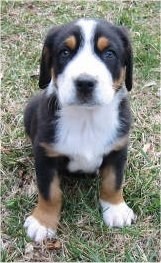This cache is part of the Snoopy series of puzzle and letterbox caches by meandmydogs. There is a rubber stamp and inkpad as well as a log book, these are not for trade! The cache is not at the posted coordinates, you will need to solve the puzzle. Everything you need to solve this puzzle is here! Please park at the parking coords and not venture in with a vehicle. Parking for one or two vehicles. From parking walk about 844 feet along the trail (East). Turn right and look for the obvious spot a few yards off the trail.
The actual cache is located in Exeter, somewhat Winter Friendly. Please place back EXACTLY as found.
Entlebucher Mountain Dog This Puppy is so darn cute!

The Entlebucher Sennenhund or Entlebucher Mountain Dog is the smallest of the four Sennenhunds, a dog type that includes four regional breeds. The name Sennenhund refers to people called Senn, herders in the Swiss Alps. Entlebuch is a municipality in the canton of Lucerne in Switzerland. The breed is also known in English as the Entelbuch Mountain Dog, Entelbucher Cattle Dog, and similar combinations.
History
All of the Sennenhund breeds are believed to be descended from large molossers brought to Switzerland by the Romans in the first century B.C. However, the Entlebucher was only described as a separate breed in 1889, although for many years little distinction was made between the Appenzeller Sennenhund and the Entlebucher Sennenhund. In 1913, four bobtail Entlebucher Sennenhund were shown to Albert Heim, an advocate for the increasingly rare Sennenhund breeds. The breed was entered into the Swiss Kennel Club stud book, but World War I intervened, and at first after the war no examples of the breed could be found. The first breed club was not formed until 1926, sixteen dogs of the type were found in 1927, and the breed slowly was restored. Although originally kept for guarding and herding, today the breed is usually kept as a lively companion.
Hope you enjoyed learning about this unique doggy!
FTF goes to Big Read